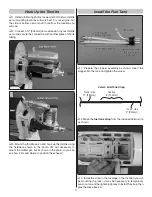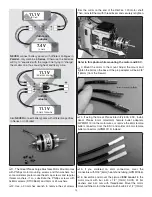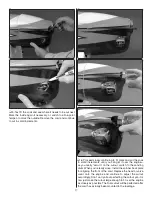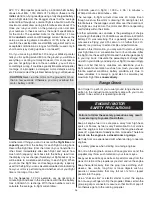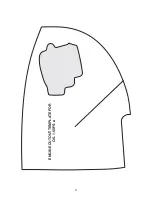
25
Balance the Model Laterally
❏
1. With the wing level, lift the model under the tail and by
the propeller shaft. Do this several times.
❏
2. If one wing always drops when you lift the model, it
means that side is heavy. Balance the airplane by adding
weight to the other wing tip.
An airplane that has been
laterally balanced will track better in fl ight and maintain
its heading better during maneuvers when the plane is
climbing.
Set the Control Throws
Measure and set the throws according to the chart below.
The measurements are taken at the
widest part
(front-to-
back) of each surface. If the endpoints in your transmitter
programming require more than a 10% to 15% change to
get the required throws, relocate the pushrods on the control
horns or on the servo arms instead. Then, go back and
perfect the throws using the programming in the radio.
These are the recommended control surface throws:
ELEVATOR
3/8"
[10mm]
7°
Up
3/8"
[10mm]
7°
Down
5/8"
[16mm]
11°
Up
5/8"
[16mm]
11°
Down
RUDDER
1-1/4"
[32mm]
13°
Right
1-1/4"
[32mm]
13°
Left
1-3/4"
[44mm]
19°
Right
1-3/4"
[44mm]
19°
Left
AILERONS
1/2"
[13mm]
9°
Up
1/2"
[13mm]
9°
Down
3/4"
[19mm]
13°
Up
3/4"
[19mm]
13°
Down
LOW RATE
HIGH RATE
PREFLIGHT
Identify Your Model
Always attach your name, address, telephone number and
AMA number somewhere on or inside your model.
Ground Check
GLOW ENGINES:
Perform your usual checks and tune the engine so it idles
and runs smoothly at full-throttle and transitions reliably
between the two. With the engine running at full-throttle,
have an assistant hold the plane in different orientations
(including nose-up and inverted) to make certain the engine
continues to run smoothly and reliably.
ELECTRIC MOTORS:
Whatever motor, battery, propeller and ESC you are running,
you should fi nd out what current and Watts your setup is
drawing before the fi rst fl ight. Once you have the data you can
compare it to the manufacturer’s specifi cations (or data from
other reliable sources) to make sure everything is operating
within its limits. Noting and recording the current and Watts
(and rpm) your system is making can also be used as a base
for comparison if experimenting with different propellers,
motors or batteries later.
There are a few ways to get this data. One way is to
briefl y
run the motor on the ground with a “Watts Up” Watt meter
(RELP0100) connected in-line between the battery and
ESC. The Watt’s Up meter will display the current (Amps),
battery Voltage and Watts. Another way is to use on-board
data logging such as an Eagle Tree Systems ELogger (
ETRP8032) or logging in your ESC. The ELogger stores
data that can be downloaded and viewed on your personal
computer. Additionally, the ELogger can be used in-fl ight to
give you a constant and more accurate picture of what the
system is doing.
Although the static (non-fl ying) data will not be the same as
what it happening in the air, it can still be used as a reference:
For example, testing has shown that the RimFire 1.20 with an
Summary of Contents for Sequence 1.20
Page 31: ...31 ENGINE CUTOUT TEMPLATE FOR O S 1 55FS a...
Page 32: ......

